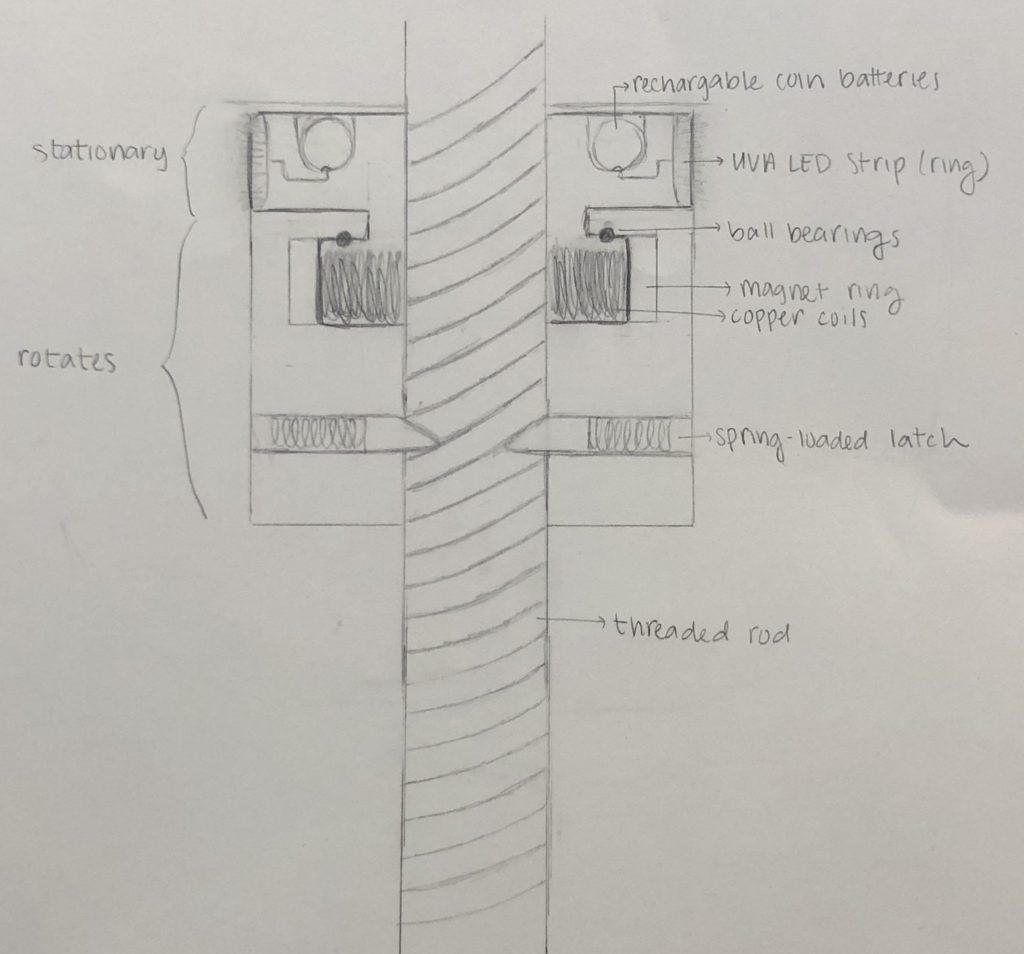One of our tentative solutions to the dengue crisis in Yemen is an extension of an existing contraption developed by the CDC, known as a CDC trap. The CDC trap is a mosquito trap initially designed to catch mosquitoes so that CDC researchers may study mosquito populations in a specific area and identify the illnesses they transmit. The CDC trap employs a small fan (powered by a 6V battery) mounted at the top of a net trap. A light and CO2 bait source are located just below the fan in order to attract mosquitoes, and the fan propels them down into the net trap where they eventually die of exhaustion (The VDCI Team, 2017).
Much like the CDC trap, our trap would utilize a light source as an attractant. A study published in Florida Entomologist suggests that blacklight is the most effective at luring mosquitoes in while simultaneously capturing the fewest “non-target insects” (University of Florida Institute of Food and Agricultural Sciences, 2015) . The two mosquito species responsible for transmitting dengue in Yemen, Aedes albopictus and Aedes aegypti, tend to be daytime biters, making visual attractants more effective. Thus, our trap would employ a blacklight to attract the mosquitoes.
The remaining parts of this solution are intended to trap and kill as many mosquitoes as possible. Using a small fan at the top would propel any nearby mosquitoes down into the trap. Portable, battery-powered fans can be found on Amazon.com for around $8-12 USD (“Amazon.com: O2COOL 5″ Portable Fan Battery Powered 1 Unit Grey: Home & Kitchen,” n.d.), (“Amazon.com: Cooler Master SickleFlow 120 – Sleeve Bearing 120mm Blue LED Silent Fan for Computer Cases, CPU Coolers, and Radiators: Electronics,” n.d.). A net with tight-nit mesh would be utilized below the fan to catch any mosquitoes. The entire trap would be coated in an insecticide to kill any mosquitoes that touch it but are not trapped by the fan and net. We have chosen to use Actellic 300CS because of its ability to kill pyrethroid-resistant mosquitoes and its ability to remain effective for up to 9 months outdoors (Hoppé, Hueter, Bywater, Wege, & Maienfisch, 2016).


The goal was to engineer a contraption that could be either self-propelled – or at least require minimal interaction. Our solution, as can be seen in the above sketches, revolves around a tightly-threaded pole that mounts directly into the ground. The mechanism attaching to the pole is separated into two parts, which glide across each other using a ring of ball bearings. The lower half of the mechanism involves two spring-loaded latches on opposite sides of the pole, which hold the mechanism inside the threads while descending (ascension will be discussed shortly). Fan propellers would be mounted around the mechanism here. The upper half of the mechanism does not rotate. It houses a ring of copper coils and an outer ring of magnets that create an electromagnetic field, propelling the rotation. Above the coils is a UVA LED strip ringing the upper outside of the trap, to lure in mosquitoes. This light would be powered by several coin batteries, which insert into the mechanism and “click” into place under a protective silicone covering. Mounted above this mechanism would be several stabilizing bars that hold the top of the mosquito net. The net hangs down like a basket and creates a seal around the pole.
The key feature of this design is the spring-loaded latches which insert into the threads of the supporting pole. The weight of the contraption would slowly pull the fan along the threads down the poll, forcing the fan blades to rotate. When the fan reaches the bottom – presumably several times a day – strong cords that exit near the bottom of the poll would be pulled to hoist the fan back to the top. The latches are designed to retreat into the mechanism at this point, bypassing the threads for ascension. When the pulling chords are released, the latches hook into the nearest thread, and the fan again begins its fall.
A tentative cost analysis has been done on some of the required materials. Actellic 300CS costs roughly $23 USD per bottle, although funding through organizations like NGenIRS have dropped the price to around $15 USD (President’s Malaria Initiative, 2017). One bottle of this insecticide could be used to treat hundreds of these mosquito traps, although that figure requires further analysis. We must perform additional research to identify the costs of the remaining required materials.
With further tweaks, this design is a feasible one. Partnered with our educational component, the people of Yemen would quickly appreciate the dangers that dengue-transmitting mosquitoes present. This trap would not take up valuable space inside of the home and requires little maintenance. The trap is modular by nature and would be easy to assemble when provided with text-free pictorial instructions. Many of the components that make up this trap could be constructed from affordable materials; the most expensive components will be the magnets and copper wire.
References
Amazon.com: Cooler Master SickleFlow 120 – Sleeve Bearing 120mm Blue LED Silent Fan for Computer Cases, CPU Coolers, and Radiators: Electronics. (n.d.). Retrieved April 23, 2019, from https://www.amazon.com/Cooler-Master-SickleFlow-120-Radiators/dp/B0026ZPFCK
Amazon.com: O2COOL 5″ Portable Fan Battery Powered 1 Unit Grey: Home & Kitchen. (n.d.). Retrieved April 23, 2019, from https://www.amazon.com/O2COOL-Portable-Battery-Powered-Unit/dp/B001B16VT6?ref_=fsclp_pl_dp_1
CDC. (2018, May 1). Mosquito Bites: Everyone is at Risk! Retrieved April 24, 2019, from Centers for Disease Control and Prevention website: https://www.cdc.gov/media/dpk/diseases-and-conditions/mosquito-borne-diseases/index.html
Hoppé, M., Hueter, O. F., Bywater, A., Wege, P., & Maienfisch, P. (2016). Evaluation of Commercial Agrochemicals as New Tools for Malaria Vector Control. CHIMIA International Journal for Chemistry, 70(10), 721–729. https://doi.org/10.2533/chimia.2016.721
The VDCI Team. (2017). Mosquito Surveillance Traps: Are They All The Same? Retrieved April 17, 2019, from http://www.vdci.net/blog/mosquito-surveillance-traps-are-they-all-the-same
